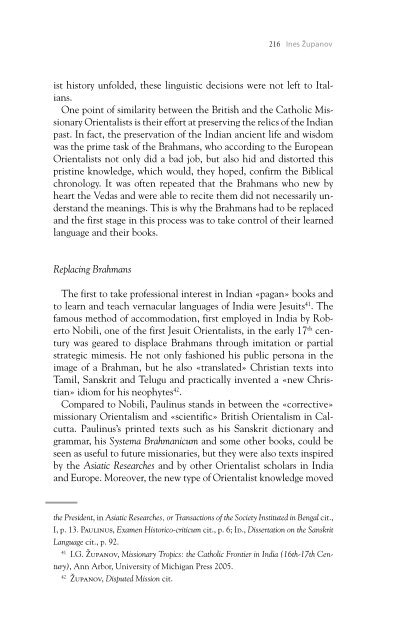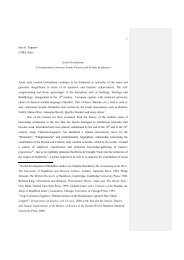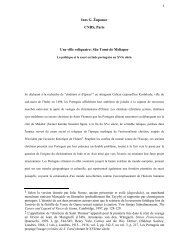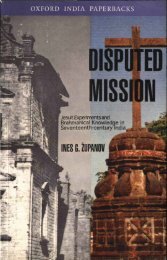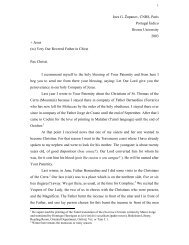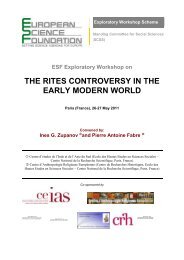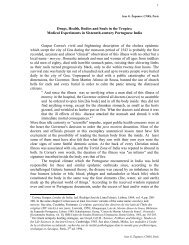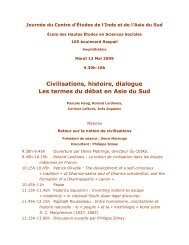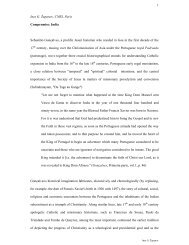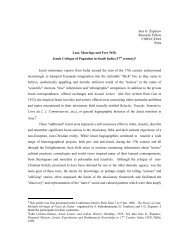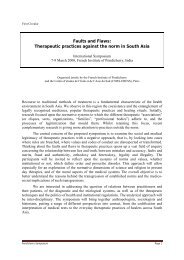Professional Missionary and Orientalist Curator ... - Ines G. Županov
Professional Missionary and Orientalist Curator ... - Ines G. Županov
Professional Missionary and Orientalist Curator ... - Ines G. Županov
You also want an ePaper? Increase the reach of your titles
YUMPU automatically turns print PDFs into web optimized ePapers that Google loves.
216 <strong>Ines</strong> <strong>Županov</strong><br />
ist history unfolded, these linguistic decisions were not left to Italians.<br />
One point of similarity between the British <strong>and</strong> the Catholic <strong>Missionary</strong><br />
<strong>Orientalist</strong>s is their effort at preserving the relics of the Indian<br />
past. In fact, the preservation of the Indian ancient life <strong>and</strong> wisdom<br />
was the prime task of the Brahmans, who according to the European<br />
<strong>Orientalist</strong>s not only did a bad job, but also hid <strong>and</strong> distorted this<br />
pristine knowledge, which would, they hoped, confirm the Biblical<br />
chronology. It was often repeated that the Brahmans who new by<br />
heart the Vedas <strong>and</strong> were able to recite them did not necessarily underst<strong>and</strong><br />
the meanings. This is why the Brahmans had to be replaced<br />
<strong>and</strong> the first stage in this process was to take control of their learned<br />
language <strong>and</strong> their books.<br />
Replacing Brahmans<br />
The first to take professional interest in Indian «pagan» books <strong>and</strong><br />
to learn <strong>and</strong> teach vernacular languages of India were Jesuits 41 . The<br />
famous method of accommodation, first employed in India by Roberto<br />
Nobili, one of the first Jesuit <strong>Orientalist</strong>s, in the early 17 th century<br />
was geared to displace Brahmans through imitation or partial<br />
strategic mimesis. He not only fashioned his public persona in the<br />
image of a Brahman, but he also «translated» Christian texts into<br />
Tamil, Sanskrit <strong>and</strong> Telugu <strong>and</strong> practically invented a «new Christian»<br />
idiom for his neophytes 42 .<br />
Compared to Nobili, Paulinus st<strong>and</strong>s in between the «corrective»<br />
missionary Orientalism <strong>and</strong> «scientific» British Orientalism in Calcutta.<br />
Paulinus’s printed texts such as his Sanskrit dictionary <strong>and</strong><br />
grammar, his Systema Brahmanicum <strong>and</strong> some other books, could be<br />
seen as useful to future missionaries, but they were also texts inspired<br />
by the Asiatic Researches <strong>and</strong> by other <strong>Orientalist</strong> scholars in India<br />
<strong>and</strong> Europe. Moreover, the new type of <strong>Orientalist</strong> knowledge moved<br />
the President, in Asiatic Researches, or Transactions of the Society Instituted in Bengal cit.,<br />
I, p. 13. Paulinus, Examen Historico-criticum cit., p. 6; Id., Dissertation on the Sanskrit<br />
Language cit., p. 92.<br />
41<br />
I.G. <strong>Županov</strong>, <strong>Missionary</strong> Tropics: the Catholic Frontier in India (16th-17th Century),<br />
Ann Arbor, University of Michigan Press 2005.<br />
42<br />
<strong>Županov</strong>, Disputed Mission cit.


